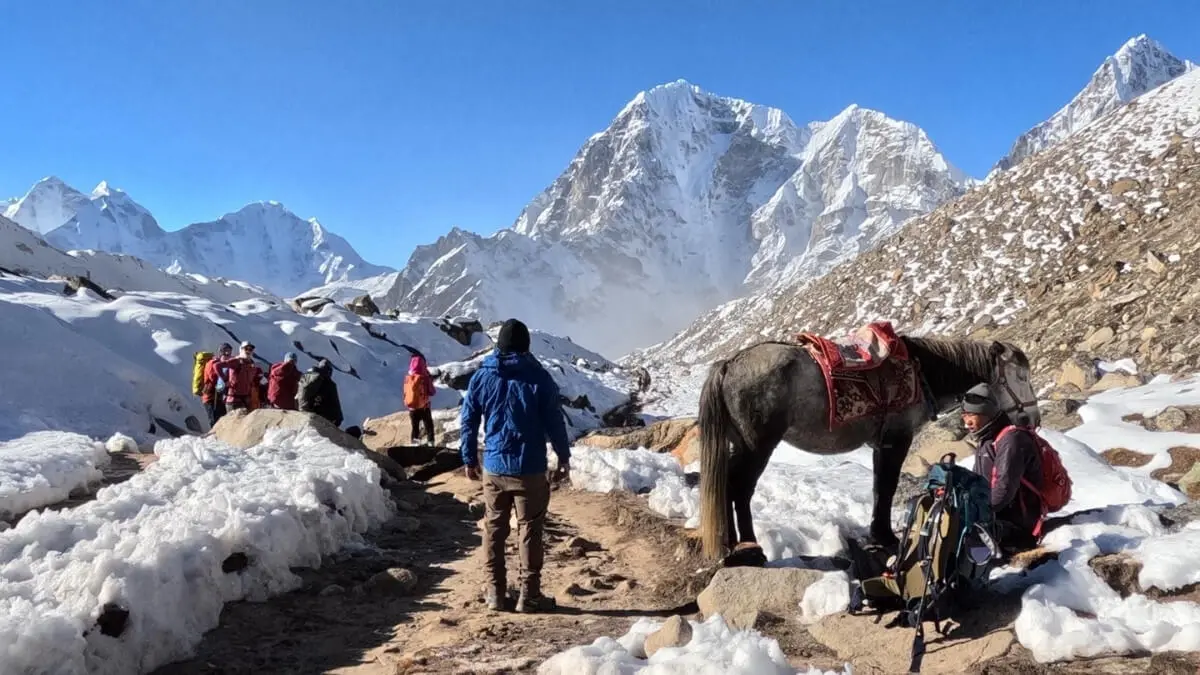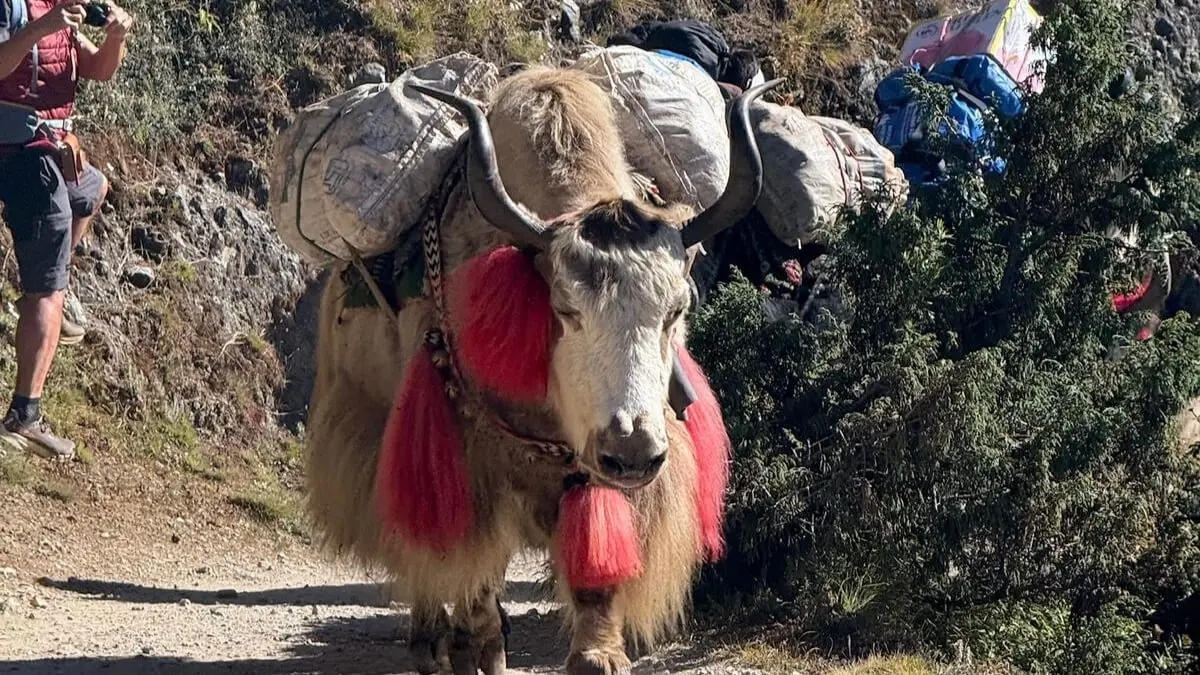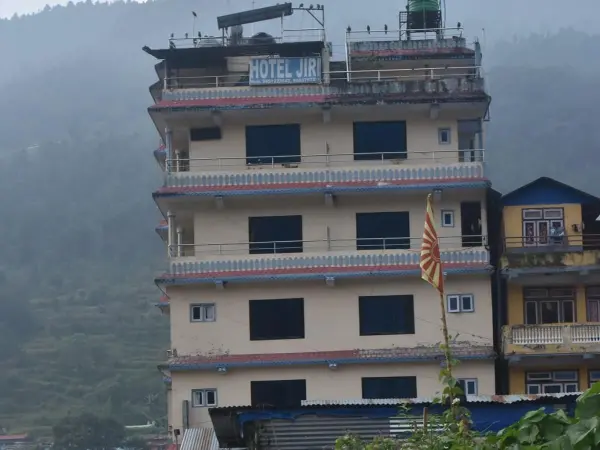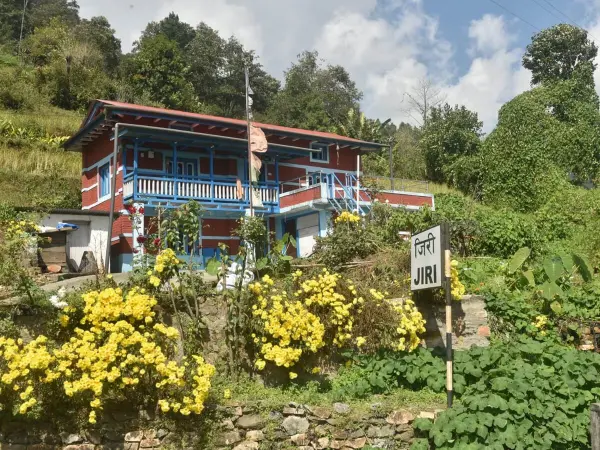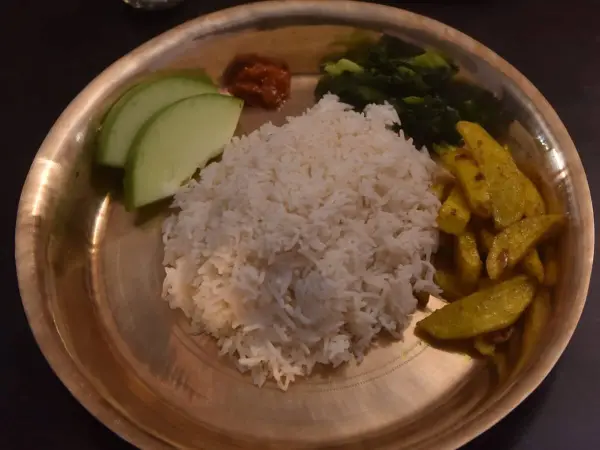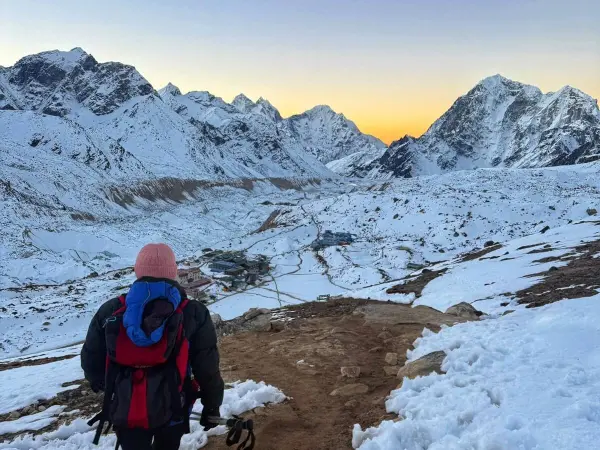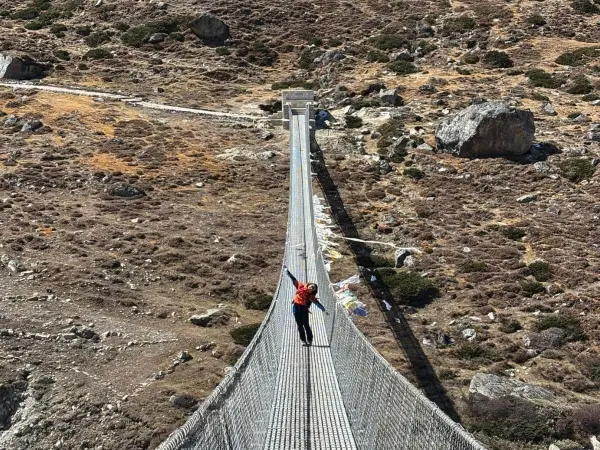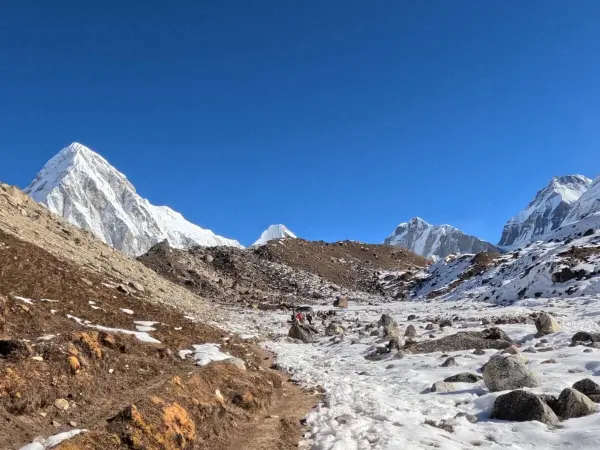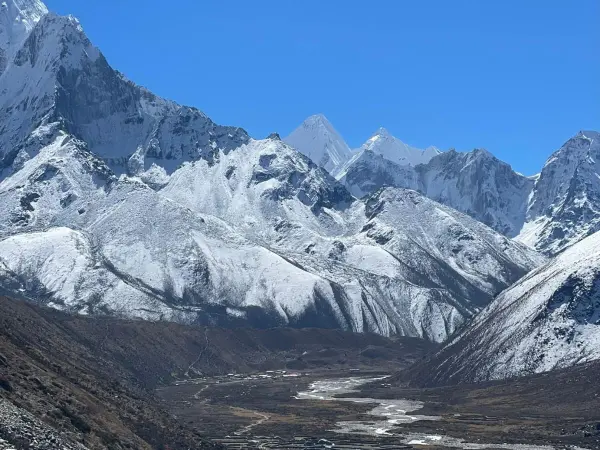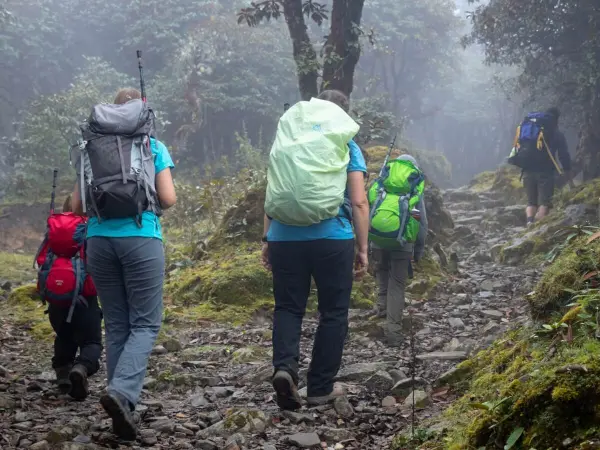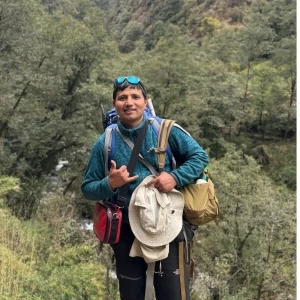Why should you choose Jiri to Everest Base Camp Trekking?
The Jiri to Everest Base Camp Trek follows the legendary route of the first Everest summiteers which offers a perfect blend of adventure, culture and stunning Himalayan scenery. Known as the Classic Everest route, the trail takes you from lush green hills through Namche Bazaar, Tengboche Monastery and up to the Everest Base Camp (5, 364 m) and Kala Patthar (5,545 m).
Unlike the short Lukla to Everest Base Camp trek, the longer Jiri to Everest Base Camp trek is less crowded trail which is perfect for the trekkers looking for an authentic Everest experience. With a gradual ascent, stunning mountain views and warm Sherpa Hospitality it provides the perfect balance of challenge and reward. From verdant valleys to towering peaks, this off the beaten path adventure rewards trekkers with Nepal’s diverse landscapes, rich history, living traditions and natural beauty in every step.
Food Menu For Jiri To Everest Base Camp Trekking
Breakfast Menu:
- Set Breakfast:(Toast or Tibetan Bread, Hash Brown Potatoes, Egg any style with Tea/Instant coffee) OR
- Oat Porridge with Jam or Honey or Fruits with Tea/Instant Coffee OR
- Any one item from Breakfast Menu at Lodge Tea/Instant coffee
Lunch Menu:
- Nepali Thali set (Dal Bhat-Steamed Rice, Lentil soup, seasonable vegetable, chicken curry, Papad and pickle) unlimited with a tea/ Instant coffee) OR
- Spaghetti/Fried noodle/Fried rice/Sandwich/Spring roll/Macaroni/Momo with a tea/ Instant coffee OR
- Any one item from Lunch menu with Luuch Menu: with a tea/ Instant coffee
Dinner Menu:
- Nepali Thali set (Daal Bhat) with a tea/ Instant coffee(Steamed Rice, Lentil soup, seasonable vegetable, chicken curry, papad and pickle) unlimited with a tea/ Instant coffee.) OR
- Spaghetti/Fried noodle/Fried rice/Sandwich/Spring roll/Macaroni /Pizza with a tea/ Instant coffee OR
- Any one item from dinner menu with a tea/ Instant coffee.
Dessert Menu:
- Each evening, we will serve fruits (Pomegranates & Apple) with some energy Bar.
Snacks :
- Whenever you stop for tea break, we will provide some cookies and nuts.
Reasons to Choose this route
The Classic Route of the Pioneers: Walk along the legendary trail of Sir Edmund Hillary and Tenzing Norgay, the same path followed by them during their first Everest Summit. It’s the original and most historic route to Everest Base Camp which offers a true sense of nostalgia and Everest adventure.
Gradual Acclimatization for Safety: As journey starts from the lower altitude of Jiri Village, this Jiri to Everest Base Camp trek allows trekkers for natural acclimatization as you gradually ascend toward Namche Bazar, Tengboche and Everest Base Camp. This slow ascent is perfect for reducing the risk of AMS (Acute Mountain Sickness) while enjoying the diverse landscapes.
Skip the Lukla Flight (Scenic Drive from Kathmandu): Avoid the flight to Lukla and begin your journey with a beautiful drive from Kathmandu to Jiri, passing through rolling hills, terraced fields and local traditional villages which gives you an authentic glimpse of rural Nepal before starting high altitude adventure.
Peaceful Trails and Fewer Crowds: Compared to Luka to Everest Base Camp trek, the classic Jiri to Everest Base Camp trail is much quieter especially in the early days making it as a peaceful trail, solitude and more of a personal trekking experience through remote villages and lush rhododendron forests.
Authentic Village Life and Sherpa Hospitality: Along the Everest Base Camp trek, you can experience a real Himalayan life by spending time in traditional Sherpa and Tamang Villages. You can enjoy some home-cooked meals, interact with locals and explore about Sherpa culture and mountain traditions that have been preserved for centuries.
Adventurous and Scenic Trail: The Everest Base Camp Trek route takes you through lush rhododendron forests, river valleys and high suspension bridges. As you walk, every day brings new adventures as you gradually approach to the heart of Solukhumbu region.
Explore Sagarmatha National Park: Enter into the Sagarmatha National Park, a UNESCO World Heritage site where you can witness rich biodiversity which includes lush rhododendron forests, Hiamalyan tahr, musk deer and colorful Danphe bird (the national bird of Nepal).
Diverse Landscapes and Himalayan Views: From the lush green valleys of Jiri to the snowcapped peaks of Everest, Lhotse and Ama Dablam, this Jiri to Everest Base Camp trek offers some of the best dramatic and diverse landscapes in Nepal.
Spiritual Touch and Ancient Monasteries: Along the trail you can discover various ancient monasteries including Tengboche, fluttering prayer flags, chortens and sacred mani walls. The region’s spiritual atmosphere adds peace to your Jiri to Everest Base Camp Journey.
Visit Tengboche Monastery: Explore Tengboche Monastery, the largest and most famous moastery in the Khumbu region which has the majestic view of Ama Dablam and Mount Everest in the background, making it as one of the most serene and photogenic stops on the Everest Base Camp trek.
Reach Everest Base Camp and Kala Patthar: Stand at the highest base camp in the world, Everest Base Camp (5,364 m) and climb to the Kala Patthar (5,545 m) for the best sunrise views over Mount Everest, a truly unforgettable moment in the entire journey.
Scenic Flight from Lukla to Kathmandu: End your Everest adventure with a short, thrilling flight from Lukla back to Kathmandu which offers a breathtaking aerial view of the Himalayas, the perfect conclusion to your classic Jiri to Everest Base Camp Trek.
What is the best season for Jiri to Everest Base Camp Trek?
The best seasons for Jiri to Everest Base Camp trek are spring (March- May) and autumn (September- November) when the weather is stable, temperatures are moderate and Himalayan views are crystal clear. During these seasons trail comes alive with blooming rhododendrons, golden valleys and perfect conditions for safe trekking and photography through scenic villages like Jiri, Namche Bazaar and Tengboche.
Meanwhile the monsoon (June – August) brings heavy rainfall with slippery trails and leeches, while winter (December- February) brings snow fall with freezing temperatures at higher altitudes such as Lobuche and Kala Patthar. Although off season trekking is possible but they required extra preparation, proper clothing and warm gear. Most trekkers prefer spring or autumn as they are perfect blend of comfort, clear skies and stunning Everest views along the classic Jiri to Everest Base Camp route.
Key Landmarks of Jiri to Everest Base Camp Trek
Jiri – The Classic Starting Point: Jiri, known as the Gateway of the Pioneers is the original starting point led by Sir Edmund Hillary and Tenzing Norgay. Along the way you can witness some beautiful terraced hills, traditional villages and lush rhododendron forests offering a naturally and culturally rich beginning to the historical Jiri to Everest Base Camp trek.
Phakding Village – Riverside Tranquility: Located along the Dudh Koshi River, Phakding serves as a peaceful overnight stop where Jiri trail meets the Lukla to EBC route. With cozy tea houses, riverside environment and sound of the flowing waters, makes this village a perfect spot to rest, acclimatize and experience the authentic Himalayan Village Life.
Namche Bazaar – The Sherpa Capital: Namche Bazaar is the heart of the Khumbu Region and an essential stop for acclimatization on the Jiri to Everest Base Camp Trek. This town is surrounded by panoramic views of different peaks such as Thamserku, Kongde Ri, Ama Dablam and Mount Everest with cafes, markets and a unique blend of Sherpa culture and modern mountain life.
Tengboche Monastery – A Spiritual High Point: Tengboche Monastery is one of the most sacred and spiritual landmarks on the Everest trail which is sourrounded by towering Himalayan peaks. The breathtaking view of Everest, Lhotse and Ama Dablam with sounds of monks chanting and fluttering prayers flags creates a peaceful spiritual atmosphere, making Jiri to Everest Base Camp trekking an unforgettable journey.
Sagarmatha National Park – A Natural Wonder- Along the trail you will be passing through Sagarmatha National Park, a UNESCO world Heritage site which is a major highlight of the Jiri to Everest Base Camp trek. The park is famous for its blooming rhododendron forests, alpine flora and rare wildlife like Himalayan Tahr, musk deer and Danphe (the National Bird of Nepal).
Dingboche – The Acclimatization Point: Dingboche located at an altitude of 4,410 meters is a perfect rest point for acclimatization on the Everest Base Camp route. Surrounded by breathtaking mountains and potato fields, this peaceful Himalayan village offers a short hike to Nangkartshang Hill for panoramic views of Ama Dblam, Lhotse and the Imja Valley.
Lobuce – Gateway to the High Himalayas: Lobuche is a rugged high-altitude village located near the Khumbu Glacier. It is the last overnight stop before Gorak shep and Everest Base Camp. The surrounding give trekkers a feeling that they have entered in the world of High Himalayas.
Gorakshep – The final base before glory: Located on a frozen lakebed, Gorak shep(5,164 m) is our final stop before reaching to the Everest Base Camp. The high altitude, cold air and close up views of Mount Everest make this one of the most unforgettable moments on the Jiri to Everest Base Camp Trek.
Everest Base Camp – The ultimate Destination: Upon reaching Everest Base Camp, it feels sense of achievement as we are standing on the highest base camp in the world, foot of Mount Everest, surrounded by climber’s tents and fluttering prayer flags. Trekkers experience a deep sense of achievement, victory and inspiration, as it is the ultimate goal of the legendary Jiri to Everest Base Camp route.
Kala Patthar – The Best Panoramic Viewpoint- Kala Patthar, located at 5,545 meters offers the best panoramic sunrise views of Mount Everest, Lhotse and Nuptse. It is one of the highest view points on Everest trek and a perfect spot for photography and memories after the long ascent for days.
Climate and Weather during Jiri to Everest Base Camp Trekking
The climate and weather on the Jiri to Everest Base Camp trek vary greatly with altitude which offers a diverse experience from lush hills in Jiri to the icy peaks near Everest Base Camp and Kala Patthar. During spring and autumn, the weather is generally clear, stable and ideal for trekking with crystal clear mountain views and comfortable temperatures, making these seasons perfect for photography and hiking.
As we climb toward Tengboche, Dingboche, Lobuche, Everest Base Camp and Kala Patthar, temperatures drop significantly and the air becomes thinner. Even during the best trekking seasons, cold winds and occasional snowfall are common. Temperatures often go below freezing point especially above Namche Bazaar. Being well prepared with layered clothing, warm gear and waterproof protection is really important across the diverse climates of the classic Jiri to Everest Base Camp Trek.
Local Culture and Tradition around the Everest Region
The Jiri to Everest Base Camp trek not only offers breathtaking mountain views but also a deep connection to the Sherpa Culture and traditions. The trail passes through authentic Sherpa villages with colorful prayer flags, mani walls, sacred chortens and ancient monasteries like Tengboche. Festivals like Mani Rimdu and Dumji fill the Khumbu region with vibrant music, masked dances and spiritual celebrations which reflects the region’s authentic Tibetan Buddhist Culture.
Temperature can be cold but the warmth of Sherpa hospitality never fades where trekkers are greeted with genuine smiles, butter tea and heartfelt kindness. From Tengboche Monastery to the remote villages of Dingboche and Lobuche, cultural encounters on the Jiri to Everest Base Camp route are as meaningful and memorable as the breathtaking Himalayan scenery itself.
Travel Insurance for Jiri to Everest Base Camp Trek
Travel insurance for the Jiri to Everest Base Camp is really important. It should cover high altitude trekking upto at least 5,500 meters, emergency helicopter evacuation and medical treatment. Since the Everest region is remote and unpredictable, having helicopter rescue insurance ensures your safety and peace of mind while trekking through the Himalayas.
Unpredictable weather conditions, altitude sickness and the remoteness of the trail can impact your journey, so making trekking insurance for Nepal is a smart choice. With proper insurance you can fully enjoy the classical Jiri to Everest Base camp trek without stress while focusing on the breathtaking Himalayan scenery and unforgettable journey.
What is Altitude Sickness can we get it during the trek?
Altitude sickness or Acute Mountain Sickness (AMS) during the Jiri to Everest Base Camp trek occurs when body struggles to adjust to the thin air at high altitude, usually above 3000 meters. The one advantage of this trek is that the trek from Jiri has gradual ascent which allows for natural acclimatization. Staying hydrated, walking at a steady place, and taking proper rest are important things to avoid AMS.
Common Acute Mountain Sickness symptoms include headaches, dizziness, nausea and loss of appetite. Proper rest and Acclimatization days in Namche Bazaar and Dingboche are crucial for safe and successful trek. Our experienced guide will monitor your health regularly and adjust the pace as needed. With proper acclimatization, awareness and expert guidance altitude sickness can be managed, allowing you to safely enjoy the Jiri to Everest Base Camp trekking adventure.
Washing and Toilet during Jiri to Everest Base Camp Trek
In lower altitude villages of Jiri to Everest Base Camp Trek, most tea houses provide basic hot showers and clean toilets. As you ascend higher into the Everest region, facilities become basic and more limited with bucket showers and squat toilets at some places. Carrying wet wipes, sanitizer and biodegradable soap help to maintain and comfort throughout the journey.
At higher altitudes, running water may freeze, making washing facilities limited. However, tea houses still maintain good cleanliness with the best resources available. At Mountface Nepal we ensure our trekkers stay in the best possible hygienic tea houses along the route for comfort and safety. By understanding these mountain conditions, it helps to set realistic expectations and enhances our authentic Himalayan trekking experience.
Jiri to Everest Base Camp Trek Difficulty: How Difficult is the Jiri EBC Trek?
The Jiri to Everest Base Camp trek is considered moderate to challenging as it involves long daily walks, steep ascents, and significant altitude gains. With good physical fitness, determination and proper preparation anyone can complete this rewarding Everest trekking adventure.
The Everest Base Camp trek is suitable for anyone above 10 years old with good physical fitness, making it an excellent choice for families and adventure enthusiasts. Hiring an experienced trekking guide is highly recommended as they monitor your health regularly and adjust proper pacing, acclimatization and safety throughout the journey. With right mindset and expert guidance, trekkers are rewarded with breathtaking Himalayan scenery and an unforgettable Everest Base Camp experience.
Accommodation and Food during Jiri to Everest Base Camp Trek
Accommodation during the original Jiri to Everest Base Camp trek is mostly in cozy tea houses, simple yet welcoming lodges with comfortable rooms, warm dining areas and delicious home cooked meals. In most of the lower altitude villages you can find rooms with attached bathrooms while at higher elevations, facilities become limited with share toilets due to limited infrastructure.
Meals are freshly prepared and typically include dal bhat (Nepalese rice and lentil soup), noodles, pancakes, chapati, bread and tea with wide range of vegetarian options available. Eating well is extremely important for maintaining energy and acclimatization at higher altitudes. The combination of warm meals, cozy lodges, and welcoming locals’ hospitality makes every stop along the Jiri to EBC trek a truly unforgettable experience.
Permit cost for Classic Jiri to Everest Base Camp Trek
The Classic Jiri to Everest Base Camp trek requires three important permits, beginning with the Gaurishankar Conservation Area permit (GCAP). This is mandatory as the Jiri to Everest Base Camp trekking route passes through the protected Gaurishankar region during the first several days of the journey. The permit costs NPR 3000 per person and can be obtained from the Nepal Tourism Board office in Kathmandu.
As we enter to the Khumbu region we will need Sagarmatha National Park Entry Permit. The permit costs NPR 3000 to enter this protected zone which is surrounded by Mt. Everest and neighboring peaks. In addition, trekkers require Khumbu Pasang Lhamu Rural Municipality Permit (NPR 3000) which replaces the older TIMS Card for this region. Both of these permits can be arranged either in Kathmandu or at checkpoints like Monjo making them very accessible for the trekkers. Together all these permits ensure legal entry for your Jiri to Everest Base Camp trek and support the conservation of these Himalayan regions.
Total Permit Cost of Jiri to Everest Base Camp Trekking is NPR 9000 that inlcudes Gaurishankar Conservation Area Permit(GCAP), Sagarmathan National Park and Pasang Lhamu National Park.
Why you should book the Jiri Everest Base Camp Trek with Mount Face Nepal?
Booking a Jiri to Everest Base Camp trek with Mount Face Nepal guarantees a safe, authentic and truly value for money Himalayan adventure. Our experienced and fully insured trekking team makes sure that your journey to the Everest base camp is managed with proper safety, comfort and acclimatization. You will be following authentic classic Jiri to Everest route once used by Sir Edmud Hillay and Tenzing Norgay, while exploring sherpa villages, experiencing warm hospitality and breathtaking views of the highest point of the earth, Mount Everest.
Mountface Nepal proudly stands out for its 95% trekking success rate which is achieved through expert leadership, personalized service and commitment to responsible tourism. We also believe in sustainable travel, donating 5% of our profits to support local communities and ensuring a fair pay for our guides, porters and staff. With customizable itineraries, eco-friendly practices and free use of our essential trekking equipment, we deliver comfort, safety and authentic cultural experiences to our trekkers. If you want value for money, authentic routes, experienced guides and heartfelt hospitality to create a truly unforgettable Himalayan journey on Jiri to EBC trek choose Mountface Nepal. “Your safety is our responsibility.”
